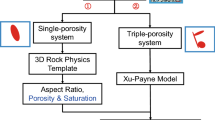Abstract
Strong heterogeneity and complex pore systems of carbonate reservoir rock make its rock physics model building and fluid substitution difficult and complex. However, rock physics models connect reservoir parameters with seismic parameters and fluid substitution is the most effective tool for reservoir prediction and quantitative characterization. On the basis of analyzing complex carbonate reservoir pore structures and heterogeneity at seismic scale, we use the gridding method to divide carbonate rock into homogeneous blocks with independent rock parameters and calculate the elastic moduli of dry rock units step by step using different rock physics models based on pore origin and structural feature. Then, the elastic moduli of rocks saturated with different fluids are obtained using fluid substitution based on different pore connectivity. Based on the calculated elastic moduli of rock units, the Hashin-Shtrikman-Walpole elastic boundary theory is adopted to calculate the carbonate elastic parameters at seismic scale. The calculation and analysis of carbonate models with different combinations of pore types demonstrate the effects of pore type on rock elastic parameters. The simulated result is consistent with our knowledge of real data.
Similar content being viewed by others
References
Abriel, W. L., 2009, Reservoir geophysics: Applications: Society of Exploration Geophysicists, Tulsa.
Avseth, P. R., Mukerji, T., and Mavko, G., 2005, Quantitative seismic interpretation: Cambridge University Press, New York, 80–120.
Ba, J., Carcione, J. M., Cao, H., et al., 2012, Velocity dispersion and attenuation of P waves in partially-saturated rocks: Wave propagation equations in doubleporosity media: Chinese J. Geophys., 55(1), 219–231.
Batzle, M., and Wang, Z., 1992, Seismic properties of pore fluids: Geophysics, 57(11), 1396–1408.
Biot, M. A., 1956, Theory of propagation of elastic waves in a fluid-saturated porous solid, I. Low frequency range, II. Higher frequency range: J. Acoust. Soc. Amer., 28, 168–191.
Biot, M. A., 1962, Mechanics of deformation and acoustic propagation in porous media: J. Appl. Phys., 33(4), 1482–1498.
Dutta, N. C., and Ode, H., 1979, Attenuation and dispersion of compressional waves in fluid-filled porous rocks with partial gas saturation (white model) Part I: Biot theory: Geophysics, 44, 1777–1788.
Dvorkin, J., and Nur, A., 1993, Dynamic poroelasticity: A unified model with the squirt and the Biot mechanisms: Geophysics, 58, 524–533.
Dvorkin, J., and Nur, A., 1996, Elasticity of high-porosity sandstones: Theory for two North Sea datasets: Geophysics, 61, 1363–1370.
Fabricius, I., Bachle, G., and Eberli, G., 2010, Elastic moduli of dry and water-saturated carbonates-Effect of depositional texture, porosity, and permeability: Geophysics, 75(3), N65–N78.
Gassmann, F., 1951, Elastic waves through a packing of spheres: Geophysics, 16, 673–685.
Ghosh, R., and Sen, M., 2012, Predicting subsurface CO2 movement: From laboratory to field scale: Geophysics, 77(3), M27–M37.
Hashin, Z., and Shtrikman, S., 1963, A variational approach to the elastic behavior of multiphase materials: Journal Mechanics Physical Solids, 11, 127–140.
Jouini, M., and Vega, S., 2011, Simulation of elastic properties in carbonates: The Leading Edge, 30(12), 1400–1407.
Mavko, G., and Mukerji, T., 1995, Pore space compressibility and Gassmann’s relation: Geophysics, 60(6), 1743–1749.
Mavko, G., Mukerji, T., and Dvorkin, J., 2009, The rock physics handbook 2nd edition: Cambridge University Press, New York, 207–311.
Nolen-Hoeksema, R. C., 2000, Modulus-porosity relations, Gassmann’s equation, and the low-frequency elasticwave response to fluids: Geophysics, 65(5), 1355–1363.
Para, J. O., 1997, The transversely isotropic poroelastic wave equation including the Biot and the squirt mechanisms: Theory and application: Geophysics, 62, 309–318.
Ruiz, F., and Dvorkin, J., 2009, Sediment with porous grains: rock-physics model and application to marine carbonate and opal: Geophysics, 74(1), E1–E15.
Sams, M. S., and Andrea, M., 2001, The effect of clay distribution on the elastic properties of sandstones: Geophysical Prospecting, 49(3), 128–150.
Sayers, C. M., 2008, The elastic properties of carbonates: The Leading Edge, 27(8), 1020–1023.
Tang, X. M., 2011, Unified theory for elastic wave propagation through porous media containing cracks-An extension of Biot’s poroelastic wave theory: Sci. China Earth Sci., 41(6), 784–795.
Vega, S., Prajapat, J. V., and al Mazrooei, A., 2010, Preliminary experiments to evaluate the Gassmann equation in carbonate rocks: Calcite and dolomite: The Leading Edge, 29(8), 906–911.
Verwer, K., Eberli, G., Baechele, G., et al., 2010, Effect of carbonate pore structure on dynamic shear moduli: Geophysics, 75(1), E1–E8.
Vialle, S., and Vanorio, T., 2011, Laboratory measurements of elastic properties of carbonate rocks during injection of reactive CO2-saturated water: Geophysical Research Letters, 38(1), L01302, 1–5.
Wang, H. Y., Sun, Z. D., and Chapman, M., 2012, Velocity dispersion and attenuation of seismic wave propagation in rocks: Acta Petrolei Sinica, 33(2), 332–342.
Wood, A. W., 1955, A textbook of sound: The MacMillan Co., New York.
Xu, S., and Payne, M., 2009, Modeling elastic properties in carbonate rocks: The Leading Edge, 28(1), 66–74.
Yang, K. D., Yang, D. H., and Wang, S. Q., 2002, Wavefield simulation based on the Boit-squirt equation: Chinese J. Geophys., 45, 863–861.
Author information
Authors and Affiliations
Corresponding author
Additional information
This research is sponsored jointly by the National Natural Science Foundation of China (No.41074098), the Key State Science and Technology Project (2011ZX05023-005-005), and China University of Petroleum (Beijing) Fund (KYJJ2012-05-08).
Li Jing-Ye: See biography and photo in the Applied Geophysics July 2012 issue, P. 148.
Rights and permissions
About this article
Cite this article
Li, JY., Chen, XH. A rock-physical modeling method for carbonate reservoirs at seismic scale. Appl. Geophys. 10, 1–13 (2013). https://doi.org/10.1007/s11770-013-0364-6
Received:
Revised:
Published:
Issue Date:
DOI: https://doi.org/10.1007/s11770-013-0364-6




